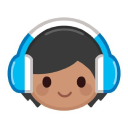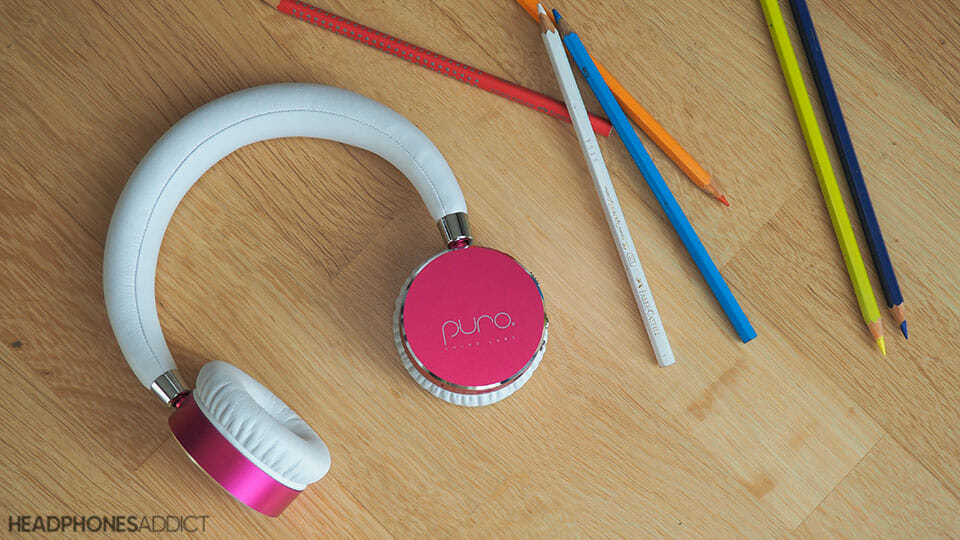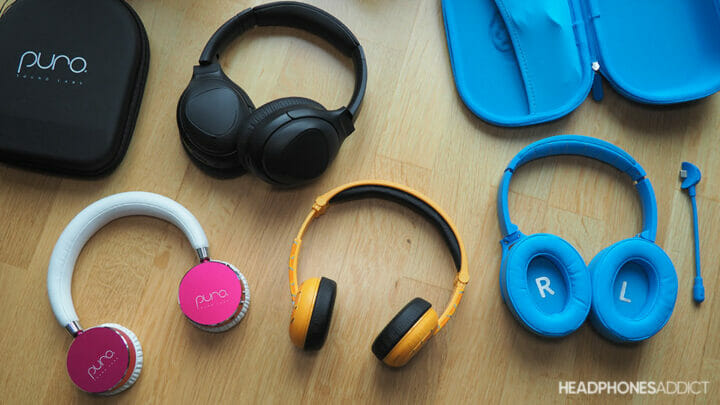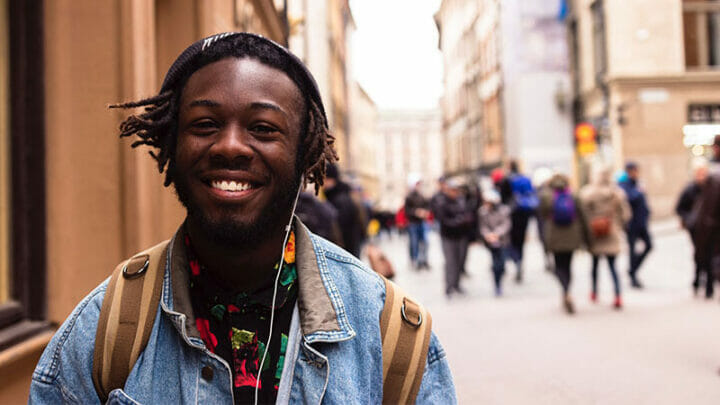We tested the 10 most popular kids’ headphones and found that 68.5% of them go over the advertised volume limit (more on that below).
The best headphones for toddlers that are safe, durable, and protect your toddler’s hearing are BuddyPhones Cosmos+ (read more).
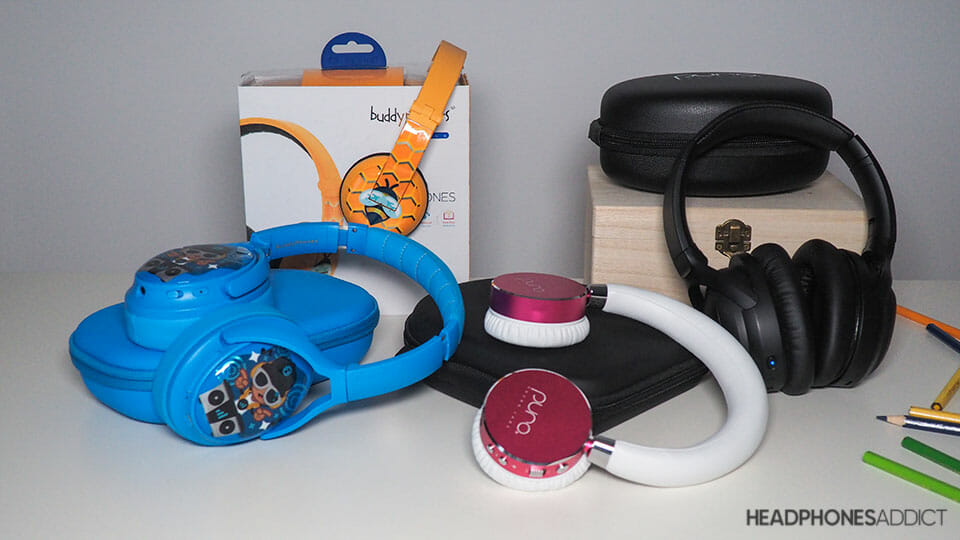
Quick Overview
- Best Headphones for Toddlers: BuddyPhones Cosmos+
- Best Durable Headphones for Toddlers: BuddyPhones Wave
- Best Toddler Headphones under $50: BuddyPhones Play+
Here are the best toddler headphones for ages 1-3 years. The main criteria we looked at are:
- Safety
- Durability
- Price
- Other features
Adult headphones aren’t suitable for toddlers because they can damage their hearing (read more below).
If you want to find safe headphones for toddlers to wear at home or a way to distract them on a long plane flight, see our list.
All headphones on our list are evaluated based on 9 key factors (Sonic9Score). The main criteria we looked at to pick the top toddler headphones are volume limiter safety, build quality, and price. See our testing and ranking methodology.
Why Many Kids Headphones Aren’t Suitable for Toddlers

Most headphones for kids come with a volume limit. However, not all are suitable for toddlers.
Kids younger than 36 months have more sensitive hearing which gets injured more easily.
According to research here: Neitzel & Fligor, WHO, and NIDCD, it’s recommended to keep 8-hour noise exposure under 80-85 dBa for kids in general.
For toddlers keep the noise exposure under 70-75 dBA.
Many headphones made for kids only limit the volume to 85-90 dB. This is too loud for toddlers.
Toddler headphones should preferably have a volume limit under 80 dB.
What we found from our test:
68.5% of kids and toddler headphones tests went over the limits advertised by the manufacturer.
You can read more about the kids headphones volume testing and see the exact results here.
Now, let’s dig into the list:
Best Headphones for Toddlers
The only toddler headphones that are safe and have a 75 dB volume limit come from the BuddyPhones brand. Other brands are limited to higher volumes over 80 dB, which aren’t the safest but better than regular headphones.
BuddyPhones Cosmos+
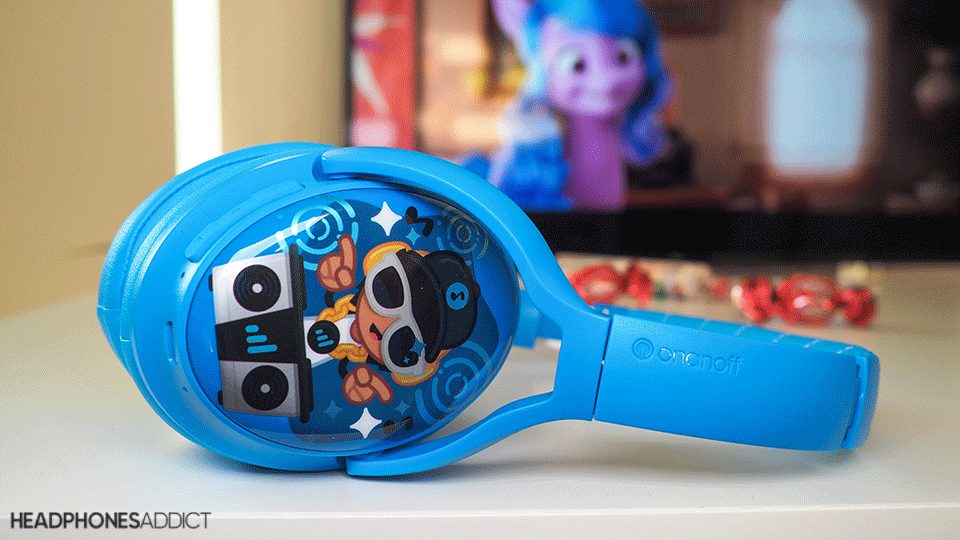
BuddyPhones Cosmos+ are the best headphones for 2-year-olds and over we’ve tested. They come with an effective volume limiter, Bluetooth connectivity, and active noise cancelling – BuddyPhones Cosmos+ review.
- Great design your kid will love
- Quality materials and sturdy, foldable construction
- 3 volume limiting modes: 75, 85, 94dB
- Active noise cancelling (ANC)
- Detachable boom microphone
- Massive battery life over 30h
- Pricey
The important thing is that you can limit them to 75 dB Toddler Mode, which is safe even for 1-year-olds. Once they grow up, you can change the mode to 85 dB Kids Mode or an even louder Travel Mode (94 dB).

Keep in mind, all the modes occasionally jump over the volume limit set by the headphones.
We found this during our testing: the 75 dB volume limit still allowed sound at 79 dB at certain points when listening to music. But most of the time, it was under the limit.
What does that mean?
It means the volume limiters aren’t 100% effective at all times. Sometimes, depending on a song, the volume will get higher than healthy.
But as long as it’s a short-term occurrence, it won’t damage the hearing of your toddler.
Now, jumping back to features. BuddyPhones Cosmos+ are great active noise cancelling headphones for traveling. ANC removes background noise and keeps flying for toddlers bearable. Let them enjoy their favorite cartoons while you get some rest.
The wireless headphones also come with a built-in microphone and a detachable boom microphone for online chatting, school, and remote learning if the need arises.
Plus, we tested the battery lasts over 38 hours, which is more than you’ll find in similar headphones. When the battery runs out, you can plug them in and use them as wired headphones.
Sound quality has a slightly emphasized bass, which comes out alive and energetic. It’s just what the little ones like. Now, we don’t put much emphasis on audio quality because this is a secondary criterion. Toddlers are too young for any audiophilic endeavors.

The only concern might be their size. Since these are over-ear headphones, they might fit loosely on a toddler’s head. The fit isn’t tight, but listening to them shouldn’t be a problem when sitting down. Thanks to the adjustable headband and swiveling ear cups they’re comfortable for small and bigger kids.
Nonetheless, these over-ear headphones are a bit too big for 1 year olds. The over-ear earcups might not fit properly on their small head just yet. But they grow fast anyway.
If you need versatile headphones suitable for play, school, and traveling, BuddyPhones Cosmos+ are your top choice.
Best Durable Headphones for Toddlers
BuddyPhones Wave
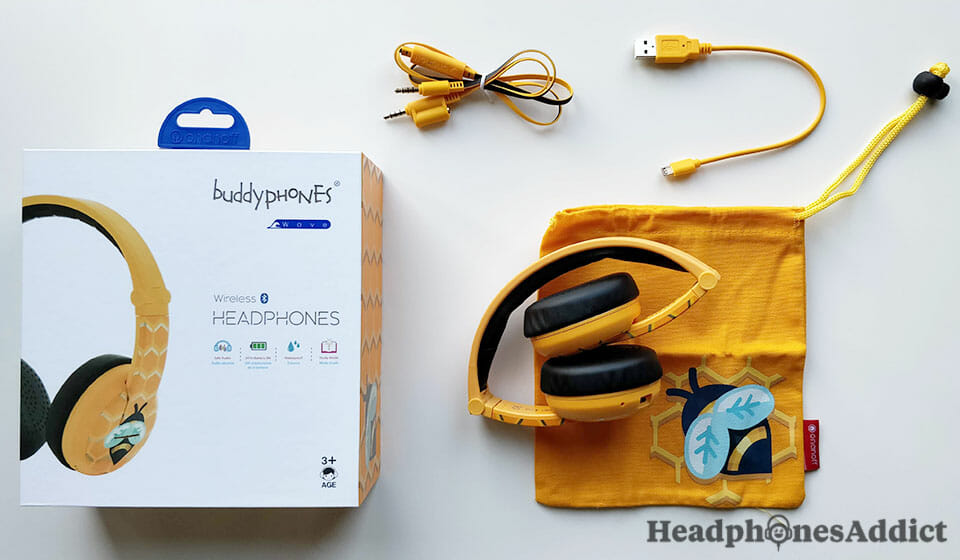
BuddyPhones Wave are the best durable headphones for “energetic” toddlers we’ve tested. With high IP67 water protection, they’re ready for all situations. – BuddyPhones Wave review.
- Waterpoof – IPX7 rating
- Effective volume limiter with 3 modes
- Colors and design
- Useful accessories (wired functionality)
- Mediocre sound quality
If you’re concerned your little one will trash the new headphones you’ll buy, then the Wave headphones make the most sense.
The lightweight plastic construction is flexible enough to survive quite a bit of abuse. And if they come in contact with water, no worries, they’re fully waterproof.
You can rinse them under tap water to get them perfectly clean again. The IP67 rating is also the highest protection against dust and sand, just in case they get buried in a playground.
Additionally, they come with 3 volume control modes, including a max 75 dB Toddler Mode. This makes them safe for 1 year olds and up. You just put them in Toddler Mode and forget about it.
You connect them with Bluetooth or a 3.5mm cable. The AUX cable has a splitter that enables other wired headphones to connect to the same music source so 2 kids can listen together.
Moreover, a 19-hour+ battery life (from our test) is plenty of juice, even for a demanding user.
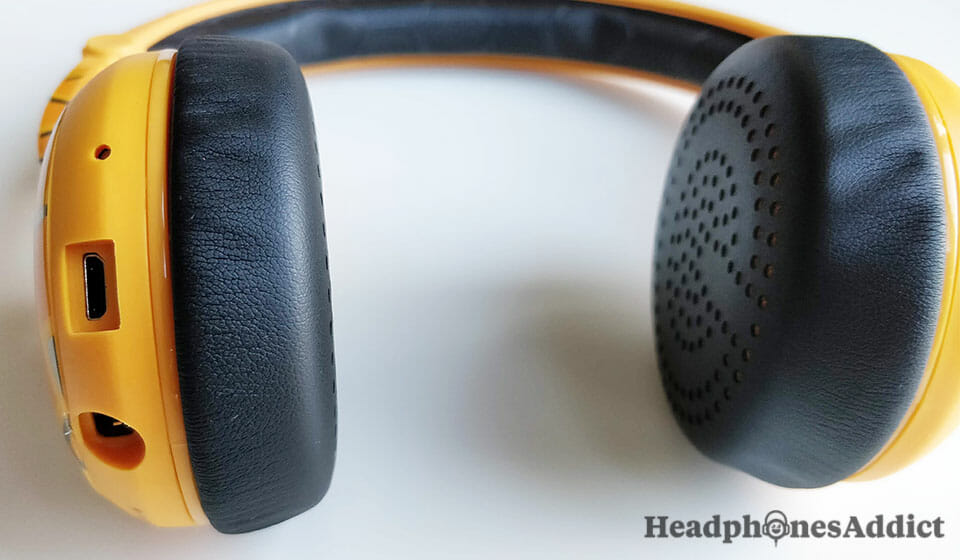
However, they have no active noise cancelling for ambient noise reduction. And despite the adjustable headband, the on-ear fit is less comfortable than the bigger over-ear fit. Also, the cushioned ear pads aren’t the thickest, but that’s probably for the better. You don’t want your toddler to wear them all the time.
If you have a rowdy toddler at home and need headphones that will survive the “tough treatment”, we recommend BuddyPhones Wave.
Best Toddler Headphones under $50
BuddyPhones Play+
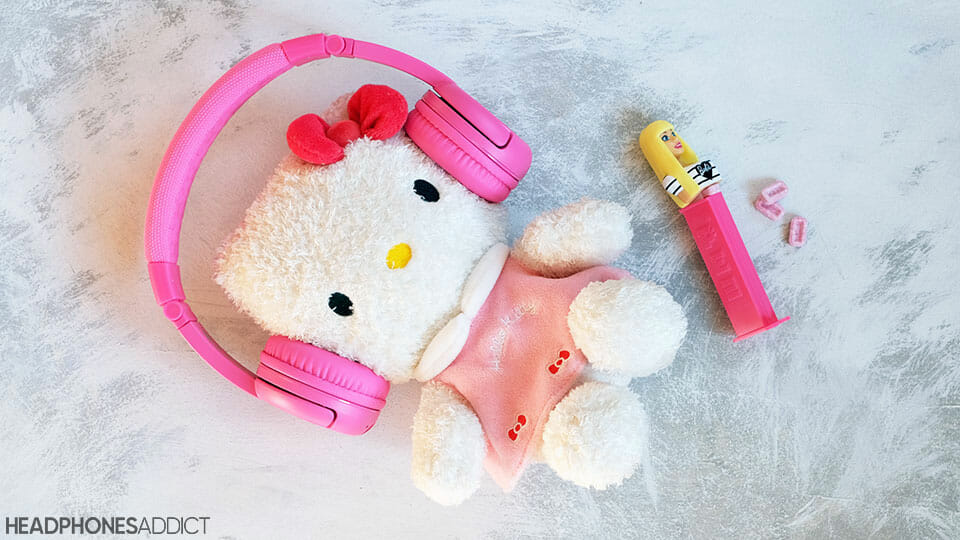
BuddyPhones Play+ are the best headphones for toddlers under $50 we’ve tested. They come with an effective 3-mode volume limiter, a comfortable fit for toddlers, and Bluetooth connectivity – BuddyPhones Play+ review.
- Great sound quality (for the price)
- 3 volume limiters
- Study mode for better concentration
- Good battery life
- Good comfort and stability
- Flexible design
- But a bit cheap-feeling
- Mediocre Bluetooth range
- No IP rating
They have 3 volume control modes, one of them Toddler Mode, which is limited to 75 dB. It’s perfect for a 2-year-old.
There’s nothing fancy about them. No active noise cancellation, no detachable microphones, or water protection.
But they do well what they promise. The Bluetooth connection makes them convenient, and you can even use them for calls with a built-in microphone.
And the sound quality is good enough for an adult, let alone a small kid.
The colorful design is flexible and won’t easily break. And best of all, they are cheap. Your kid can customize them with stickers in the box. There are many colors to choose from.

You can connect them to any Bluetooth device, smartphone, tablet, TV, Bluetooth MP3 player, etc. And if the 20-hour battery runs out, you can use them as wired headphones indefinitely.
For around $50, they’ll fit a toddler, protect their hearing, and last long enough to justify the price. What’s not to like?
If you’re looking for budget headphones for toddlers, BuddyPhones Play+ are the way to go.
Runner-Ups: Other Models to Consider
Puro Sound Labs BT2200
Puro BT2200 are older (but still good) Bluetooth on-ear headphones with adult-like styling and limited volume. They’re fixed to a max volume of 85 dB (can’t be changed). This is slightly higher than recommended. This means you, as a parent, will have to supervise more and make sure the volume isn’t ramped up to max. There’s no active noise cancelling like in the PuroQuiets model below. Puro Sound Labs BT2200 review
Puro Sound Labs BT2200 Plus
Puro BT2200 Plus are the updated version of the popular Bluetooth headphones for kids. They come with bigger earpads (suitable for an adult) and great sound quality for kids’ headphones. But their volume limiter is less effective than with the older model. Find the details in the review. Puro Sound Labs BT2200 Plus review
BuddyPhones Explore+

The BuddyPhones Explore+ are cheap wired headphones for toddlers with a stable fit for outdoor activities and exploration. They sport a detachable cable, volume limiter (85dB), and decent sound quality. For the price of only $30, they’re worth checking out. BuddyPhones Explore+ review
Headphones That Didn’t Make The List:
- Puro Sound Labs PuroQuiets: These pricey active noise cancelling headphones are unsuitable for toddlers because the volume limiter is set at 85 dB, which is too loud.
How We Tested
We focused on the volume limiter effectiveness as the main criterion for toddler headphones. Keeping the loudness under 80dB is a must-have feature, in our opinion.

Each pair of headphones was objectively measured for maximum loudness in different modes. We tested them in wireless Bluetooth mode and with a cable.
After measuring the volume limiter, we focused on other things. Altogether, we tested them on 9 key points (our testing methodology): Sound quality, ANC, battery life, comfort, features, etc. After testing, we scored them according to our scoring methodology. In the end, we got our rating, the Sonic9Score. This helped us compare and pick the best-performing headphones that we can confidently recommend.
How did we choose the models?
Even though we tested 192 headphones, we only considered kids headphones for obvious reasons. We ranked them according to the scores in the main criteria mentioned above and listed them at different needs and prices.
How to Choose Headphones for Toddlers and How are They Different from Regular Headphones?
The main things to look for are:
Volume limiting
Safety comes first. And toddlers have extra sensitive hearing. Like we’ve established before, it’s even more sensitive than with older kids over 3 years.
For this reason, it’s crucial to give toddlers headphones that are made for sensitive children’s ears.
The volume has to be lower than with regular kids’ headphones. Look for under 80 dB volume limit, preferably under 70 – 75 dB.

And regular headphones are “no bueno” as they are too loud and can hurt a child’s hearing.
Durability
1-year olds aren’t exactly gentle creatures. They’re still learning about the world and trying different things.

Throwing is part of the learning process. Older kids, 2- and 3-year-olds are usually more careful with their items, but accidents still happen.
For this reason, you want lightweight, flexible headphones that won’t break if they get thrown around a bit.
Even if you get the cheaper ones, you still want to protect your investment. Nobody wants to buy new headphones every couple of months.
Some headphones are waterproof and dustproof for top-notch durability.
Price
Sure, all parents want the best for their little ones. But that doesn’t mean you have to buy the best and most expensive things for them all the time.
Suppose your toddler occasionally needs headphones to watch some cartoons on a tablet. In that case, it doesn’t make sense to buy the most expensive ones with all the features.
As long as they’re safe and do what you want them to do, you can easily get away with buying an older model that costs less.
Generally, the prices of volume-limiting headphones for toddlers range from $50 to over $100 for premium models. It can get pricey if you buy more than 1 pair.
Features

The right fit and size for a toddler are the obvious requirements. You want headphones that sit comfortably on small heads.
But there are a couple of optional features that each solve a different problem:
- Active noise cancellation: If you want to protect your toddler’s hearing during long haul flights, get noise cancelling headphones to lower background noise exposure like airplane engines.
- Water protection: If your toddler is energetic and likes to experiment with throwing headphones in milk and cereal, then get waterproof headphones for better durability.
- Wireless or wired: While we recommend wireless headphones for sheer convenience, you can still get wired headphones. Bluetooth headphones are generally better but wired headphones tend to be cheaper and often enough for a light user.
- Battery capacity: Since charging the battery will probably fall on your shoulders, you want decent battery life.
- Foldable body: If your toddler is likely to travel with headphones, then a foldable design that’s easy to store in a carry bag is the best.
Why adult headphones aren’t suitable for toddlers?
Normal headphones made for adults are too loud. AirPods 3, the most popular headphones in the world, reach 105.7dB in volume at max level.
This is too loud, according to many sources: Neitzel & Fligor, WHO, and NIDCD, who recommend keeping the volume under 80 dB.
At 105dB loudness, according to the sources, noise-induced hearing loss can occur in less than 1 hour.
FAQ: Frequently Asked Questions
Can toddlers use headphones?
Toddlers can use headphones as long as the maximum volume is limited, recommended under 75 dB, and for a limited time of a couple of hours. Prolonged exposure to higher volumes can lead to hearing loss into adulthood.
Are headphones safe for toddlers?
Limited and supervised use of headphones is safe for toddlers. The safest are dedicated toddler headphones, volume-limited under 75 dB. And made from parts that can’t be swallowed by a curious kid. However, unsupervised use of adult headphones can be dangerous.
At what age can a toddler use headphones?
The moment a toddler is interested in audio and can comfortably wear headphones is from 12 months and older. But it should be time-limited and at lower volumes. Keep the volume under 50% of max as a general guideline.
Are noise cancelling headphones good for toddlers?
Active noise cancelling headphones are useful for reducing ambient noise on a flight. If you often travel with your toddler, you can protect their hearing. But for listening at home, they’re not necessary.

Matija Ferjan is a seasoned audio enthusiast reviewing headphones since 2015. He has personally tested hundreds of headphones and earbuds. He’s an active member of the Headphone Audio community and a true nitpicker, always looking for the “best-value-for-money” headphones.




